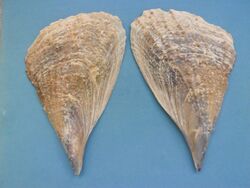Biology:Atrina seminuda
| Atrina seminuda | |
|---|---|

| |
| Scientific classification | |
| Domain: | Eukaryota |
| Kingdom: | Animalia |
| Phylum: | Mollusca |
| Class: | Bivalvia |
| Order: | Pteriida |
| Family: | Pinnidae |
| Genus: | Atrina |
| Species: | A. seminuda
|
| Binomial name | |
| Atrina seminuda (Lamarck, 1819)
| |
Atrina seminuda, the half-naked pen shell, is a species of bivalve mollusc in the family Pinnidae.
Description
It is characterized by a large shell between about 150–200 mm in triangular or wedge, the leaflets have ornamentations forming rows 10-20 tubular radial spiny projections which are often slightly curved. The surface of the leaflets tend to observe fine markings which correspond to the long lines. The coloration is variable ranging from dark brown to greenish brown. In the animal body highlights large posterior adductor muscle development, which in individuals of sizes between 150 and 200 mm can reach a diameter of about 40 mm.[1][2]
Distribution
It can be found along the Atlantic coast of North America, ranging from North Carolina to Texas and south to Argentina .[1][2][3] For the Venezuelan Caribbean has been appointed to the coasts of the states of Vargas, Miranda, Anzoátegui, Sucre and Nueva Esparta.[1][2][4][5]
Habitat
Atrina seminuda, is an endobenthic inhabitant, usually secured by a strong byssus secreted by the animal in rocks and gravel substrate in areas of high energy.[2] Associated with the outer faces of the leaflets of Atrina seminuda usually inhabit a range of fouling organisms among them being common gastropod mollusks, bivalves and chitons.[6]
Gallery
Commons names
Venezuelan folk tradition on its shores this bivalve is known under several names like so: rompechinchorro,[1] hacha,[1] cocha abanico,[1] papa reina[7] y cucharon[8]
References
- ↑ 1.0 1.1 1.2 1.3 1.4 1.5 Lodeiros Seijos, J.M., Marin Espinosa, Baumar. y Prieto Arcas, Antulio. 1999: Catalogo de moluscos marinos de las costas nororientales de Venezuela: Clase Bivalvia. Asociación de Profesores de la Universidad de Oriente, Cumaná - Venezuela 112p.
- ↑ 2.0 2.1 2.2 2.3 Macsotay O. & Campos. R. 2001. Moluscos representativos de la plataforma de Margarita. Editora Rivolta. Valencia. 280p. ISBN:980-328-808-3
- ↑ Abbott, R.T. & Morris, P.A. A Field Guide to Shells: Atlantic and Gulf Coasts and the West Indies. New York: Houghton Mifflin, 1995. 25.
- ↑ Tello, J. 1975: catálogo de la fauna venezolana.VII. Mollusca. C.O. III Conferencia de la Naciones Unidas sobre el derecho del Mar. 599p.
- ↑ Ramós, G.H. y Robaina, G. 1994: Contribución a la conocimiento de los moluscos gasterópodos y pelecipodos de la bahía de Mochima, Edo. Sucre, Venezuela. Memoria de la Sociedad de Ciencias Naturales La Salle, 54(141):95-106
- ↑ "Rodríguez P., Oscarlina Del V. 2011: Fauna malacológica epibionte del cucharón Atrina seminuda (Lamarck, 1819) (Bivalvia: Pinnidae) al norte de la península de Araya, Estado Sucre. Universidad de Oriente. Trabajo Especial de Grado Cumaná. 58p.". http://ri.biblioteca.udo.edu.ve/bitstream/123456789/3155/1/TESIS_OR.pdf.
- ↑ Cervigon, Fernando. y Velázquez Efigenio. (1981): Nombre vernáculos de organismos marinos del Estado Nueva Esparta. Fernando Cervigon Editor Caracas-Venezuela.
- ↑ Costas de Venezuela: Cucharón, Atrina seminuda (Lamarck, 1819)
External links
- World Register of Marine Species (Worms): Atrina seminuda (Lamarck, 1819) AphiaID: 420740
- Integrated Taxonómica Informatión System (ITIS): Atrina seminuda (Lamarck, 1819) Taxonomic Serial No.: 79580
- Smithsonian National Museum of Natural History: Atrina seminuda
- Biodiversity Heritage Library (BHL): Atrina seminuda
Wikidata ☰ Q3016811 entry
 |



